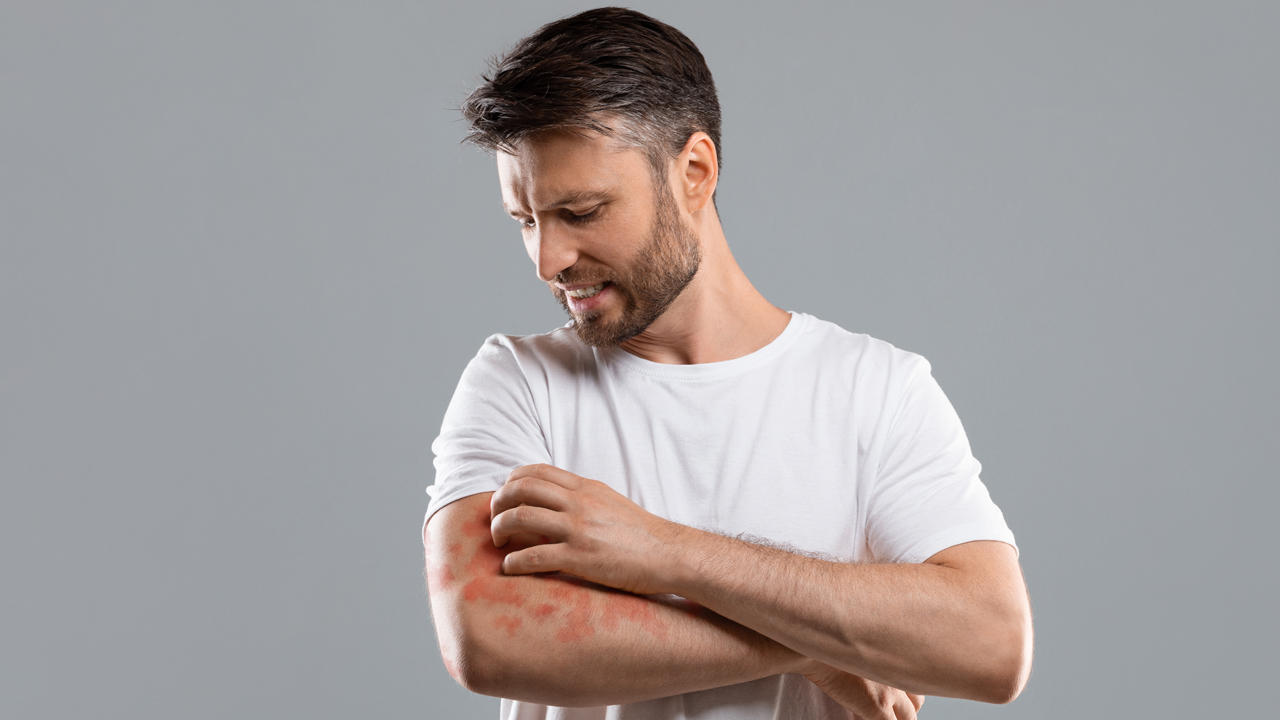In Clinical
Follow this topic
Bookmark
Record learning outcomes
Skin conditions are among the most common reasons for patients to visit their pharmacy for treatment and advice. Here is a concise guide for dealing with eczema, psoriasis and acne
Atopic Eczema
A chronic, relapsing-remitting inflammatory skin condition, which is highly pruritic (itchy) and most frequently presents in children.
Occurs in 10-30 per cent of children and in 2-10 per cent of adults. Eczema disappears in around three-quarters of children by the age of 16 years.
Dry, scaling, erythematous, pruritic skin, although weeping/crusting and vesicles may also be present. Over time, the skin becomes less red but thickened with cracks and fissures due to constant scratching.
Ask about itch – if absent it is unlikely to be AE!
Itch and lack of sleep negatively affect quality of life. Children are often irritable and inattentive with severe pruritus.
Regular and frequent use of emollients applied to the whole body and used instead of soap to wash/bath/shower even when skin is clear. Prescribed quantities should be 250g-500g per week.
Adherence to emollients is strongly influenced by cosmetic acceptability on the skin, so patients should be allowed to find a product they are happy to use.
Topical steroids for red/itchy areas of skin and stopped once the inflammation has resolved although emollients should continue. Apply emollients around 20 minutes before topical steroids and use the finger-tip unit to gauge the amount of topical steroid to apply.
Atopic eczema is incurable but frequent moisturisation can limit disease flares.
Avoid known triggers wherever possible including soaps, synthetic fabrics and wool to help minimise disease flares. Cotton fabric is often tolerated by sufferers.
Certain foods (e.g. milk, eggs, wheat, soy, peanuts) may trigger a disease flare and should be avoided if linked to disease worsening.
Evidence of bacterial infection (oozing fluid, crusting; swollen, inflamed skin).
Evidence of viral infection (eczema herpeticum) with painful, fluid-filled blisters often on the face or neck, which ooze or weep with associated systemic upset.
Infants: normally seen on the face, scalp and extensor surfaces
Children: localised to the inner elbow creases and behind the knees
Adults: can appear anywhere but often seen on the hands.
Psoriasis
A systemic, chronic and complex, immune-mediated, inflammatory skin disease.
Occurs in 1-3 per cent of the population with two peaks in incidence at 20-30 and 50-60 years of age. The most common form (around 90 per cent) is chronic plaque psoriasis which, once developed, is life-long.
Erythematous, symmetrical, pruritic, raised plaques covered by silvery-white, adherent scale typically seen on extensor surfaces (e.g. elbows and knees) as well as the trunk and scalp.
Nail changes such as ‘pitting’ (pin-point depressions in the nail plate) or discoloration of the nail and over-production of the nail bed (subungual hyperkeratosis) also commonly seen.
Major social and psychological effects negatively impacting on quality of life, in some cases causing depression and suicidal ideation.
Co-morbidities including psoriatic arthritis (up to a third of patients) and cardiovascular disease worsen the impact on quality of life.
Potent topical steroids in combination with vitamin D analogues applied either separately or in a single combination product.
Treatment for at least four weeks before assessment and then continued until the raised plaques flatten.
Topical steroid use limited to eight weeks but vitamin D analogues can be used long-term.
Emollients for washing/bathing/showering and as a ‘leave-on’ product (applied 15-30 minutes before other treatments) help to reduce scale, improve plaque appearance and make the skin more comfortable.
Psoriasis is incurable but follows a relapsing-remitting pattern requiring intermittent use of treatment.
Typical triggers include drugs (lithium, anti-malarial agents, NSAIDs and ACE inhibitors), psychological stress, smoking, alcohol intake and, in some women, pregnancy.
Skin trauma due to scratching, piercing and tattoos can lead to psoriasis at the site of injury (Koebner’s phenomena).
Psoriasis generally improves for most after UV exposure.
There are no effective treatments for psoriasis available from pharmacies and so patients should be referred to their GP. However, patients with very mild, limited disease may find emollients helpful.
Acne
An inflammatory skin disease mainly affecting the face (99 per cent), back (60 per cent) and chest (15 per cent) due to blockage of the pilosebaceous units (hair follicle and sebaceous gland).
Occurs in 95 per cent of adolescents and up to 3 per cent of adults aged 35-44 years.
Greasy skin with non-inflammatory (open and closed comedones) and inflamed lesions (e.g. papules, pustules) on affected areas. More severe disease has nodules and cysts (deeper, palpable lesions).
Categorised as mild (mainly non-inflamed lesions), moderate (more widespread with inflammatory lesions) or severe (widespread with nodules and cysts with scarring).
Social and psychological problems due to effect on self-esteem, leading to depression and anxiety.
Mild disease: topical retinoid and benzoyl peroxide, either alone or in combination.
Moderate disease: as for mild disease plus oral antibiotic (lymecycline, doxycycline, trimethoprim) for no longer than three months.
Severe disease: isotretinoin (most effective treatment) prescribed in secondary care.
Irritation/dryness from topical treatments can be minimised by initially applying for 30-60 minutes before washing off and gradually increasing contact time.
Combined oral contraceptives can be used either alone or combined with topical or systemic agents.
For most patients acne resolves in early adulthood.
Triggers include psychological stress, a high glycaemic index diet, cosmetics (due to blockage of pilosebaceous units), and drugs such as anabolic steroids, lithium; topical and systemic corticosteroids.
Patients whose acne has not responded to topical or systemic therapy after 12 weeks.
Those with mild acne and evidence of scarring. Acne is rare in very young children and such patients should also be referred.
Rare forms of acne requiring urgent referral:
- Conglobate acne – characterised by extensive inflammatory papules, suppurative nodules and cysts on the trunk and upper limbs
- Acne fulminans – sudden severe reaction causing deep ulcerations and erosions with systemic upset.

